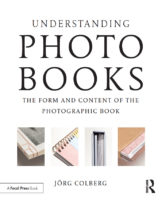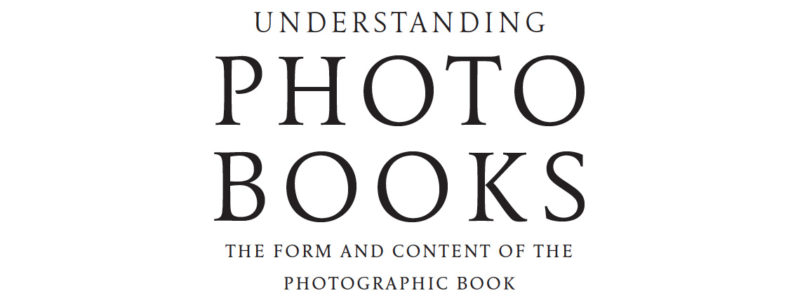Roughly two years ago, Focal Press approached me to inquire whether I was interested in writing a book. I was. Given the fact that I had been spending a lot of time dealing with photobooks, here was a topic I wanted to dive into more deeply. As frequent visitors of this site know, I have been reviewing photobooks for some time now (here is a list of all rated book reviews). As part of my teaching responsibilities, I have also had to work with photographers making books.
Contrary to what is widely believed, photobooks are very complex objects. It is true, you can make a photobook by dropping your pictures into some Blurb or InDesign template, and sending the files off to some printer you have never met (or possibly don’t even know), to then get something that looks like a photobook in the mail. But that’s a bit like buying a cake mix in the supermarket: unless you really screw up, you end up with an OK cake.
There are many books about photobooks available now, which, thankfully, allows those interested in the medium to get an idea of its history and of various of the past or present trends. Martin Parr and Gerry Badger have provided the photography community with an invaluable service by publishing their series on the history of the photobook. And there are many other such books, usually focusing on one particular region and then listing all the books you just need to know. These books are great for collectors and for photographers. As a photographer, you can get inspired by those that came before you.
But there is a lot less information available about how to actually do this, how to make a photobook — beyond the aforementioned “on-demand” or quick template-based approaches. Consequently, a lot of photographers trying to make a book realize that they’re fighting what often feels like a pretty tough uphill battle. It’s not only that having to edit and sequence one’s photographs is very hard. There’s just so much more to a book than that.
If you decide to do it all yourself — self-publishing has become a widely accepted way of making photobooks, you have to solve all those problems you had no idea they existed in the first place. Usually, those problems come one after the other. You’ve solved one, and two new ones pop up. Turns out every self-publisher is facing the very same problems. Yet despite the popularity of self-publishing there are few in-depth resources available about how to actually do things.
If you decide to approach a publisher, you’ll face a series of similar challenges, which actually do not stop once someone decides they will add you to their roster of artists to publish. Suddenly, there are all those people who want to have a say concerning your book. Wasn’t this supposed to be your book?
Given the preceding, I decided I was going to write a book about how all of that actually worked. What do you have to think of as a photographer when you publish your photobook, regardless of whether it’s self-published or going through a commercial publisher? From my teaching experience and from having talked to a lot of people in the business I know that many photographers are unaware of many aspects of photobook publishing. And how would you know if nobody ever tells you what do to?

The idea for my book was to tackle each and every aspect around photobook publishing in a way that would be most beneficial for photographers (and, consequently, for viewers or collectors who would rather look at well-made books). This resulted in what is now available as Understanding Photobooks: The Form and Content of the Photographic Book. In a nutshell, it’s a “how to” or “what do you do” book.
More specifically, the book educates photographers about what it is they have to do when facing the task of publishing a book. It covers every aspect of book publishing in some form, ranging from the business of publishing to thinking about the concept of the book to editing/sequencing to design to production. Given that is a lot to consider, photographers need not worry they will have to become experts concerning each and every aspect, though. For example, while the role of design is explored and discussed, every photographer who is not a trained graphic designer should work with a professional.
So the focus of the book is to help photographers gain a lot better understanding of the tasks that are specifically theirs (in particular thinking about the concept of their book and editing/sequencing) and to provide them with enough insight into all the other aspects that they know who else to talk to and what about.
I know quite a bit about photobooks, but much like most photographers, I’m no in-depth expert on many of the issues discussed in the book. I’m not a graphic designer, I’m not a producer etc. It is for this reason that I have consulted with a large number and variety of photobook experts, to use their input for the book. These experts include photographers themselves, publishers, designers, editors, critics, and book sellers.
As one could imagine, there isn’t necessarily agreement between, say, designers about what good photobook design actually is. There will be an overall agreement concerning what it does and what main aspects have to work, but the details might differ considerably. So Understanding Photobooks approaches many of the aspects of photobooks on an “as needed” basis. In other words, it’s not so much about providing another cake mix — “these are all the details for how to go about this” — as an overall plan how to approach book making: “you will have to consider these aspects, and based on your book’s specific needs, come to an understanding how this works in this particular case.”
The book discusses many examples of how to think about editing and sequencing. But it also tackles less commonly discussed aspects such as what different bindings actually do. A series of books are discussed in separate, isolated sections, with input from different experts on how they actually work. I’m not after discussing “is this a good book?” Instead, I want to dive into “how does this actually work, and why does this make it a good book?”
As can be expected, the editing/sequencing chapter is the longest, the one whose writing produced the largest number of grey hairs for me. Editing and sequencing photographs is a very tough job, and I am very content with the almost fifty pages that discuss how to go about it.
I’m hoping that Understanding Photobooks: The Form and Content of the Photographic Book will help make photographers’ lives easier once they want to make a book. At the same time, the book was not written merely for photographers or those active in the world of photobooks. Even if you don’t want to make a photobook but want to understand the medium better, my hope is this book will help you get there.
